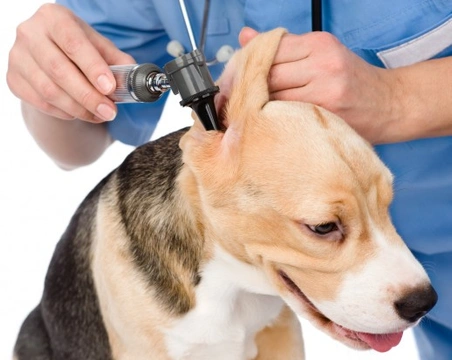
Symptoms of a perforated eardrum in the dog
The eardrum of the dog is a thin membrane within the ear that divides the exterior of the ear from the middle and inner parts of the ear. It cannot be seen from outside of the ear, as it is a relatively long way down the ear canal itself. If your dog suddenly seems to be having problems hearing in one ear (or even both) and there is no obvious cause, such as an ear mite infestation or build-up of ear wax, a perforated eardrum may be the problem. In the long term, this can lead to permanent deafness if untreated, as well as pain and problems with balance.
In this article, we will look at the function of the eardrum in more detail, as well as how to tell if your dog has potentially perforated their eardrum. Read on to learn more!
More about the eardrum
The membrane that makes up the eardrum fulfils the main purpose of transmitting sound waves in the air to the three bones of the middle ear, which then carry the sound to the labyrinth and onto the brain to be decoded. The eardrum cannot be seen or touched from the outside of the ear, which goes a long way to keeping the delicate membrane protected from damage, but nevertheless, perforations of the eardrum can still potentially occur.
Some of the potential things that can rupture the eardrum include:
- Sudden changes in atmospheric pressure
- An infection of the middle ear
- Extremely loud noises, particularly at close range
- Direct damage to the eardrum, for instance by inserting things into the ear
- Toxin exposure
- Foreign objects working their way through the ear down onto the eardrum
The symptoms of a perforated eardrum in the dog
If your dog’s eardrum has been perforated, you will probably become aware of a range of signs that tell you this in short order. Keep an eye out for the following signs and symptoms in the dog:
Ear pain
A perforated eardrum is painful for your dog, and your dog will usually alert you to the presence of pain in their ear by crying, pawing at the ear, or showing reluctance to have their head or ears touched.
Discharge from the ear
If your dog’s eardrum has ruptured due to an ear infection, a relatively common cause for perforation, infected discharge from within the middle ear can place pressure on the membrane, leading the rupture and then, the discharge of infected liquid. This may appear pussy, bloody or water-like.
Loss of hearing
The eardrum is an integral part of how your dog hears and processes sounds, and damage to the eardrum itself will generally have a significant effect on your dog’s ability to hear properly. It is not always obvious at first if your dog has compromised hearing, so look out for the signs of this in particular if it comes accompanied by other symptoms.
Problems with balance
The ears actually have a surprising amount of impact on how your dog balances and maintains their coordination, due to the balance of pressure within the ears. A perforation can interfere with this, and may lead to your dog becoming rather clumsy or less sure footed as their internal balance has become compromised.
Look at the face
In some cases but by no means all, the sympathetic facial nerves that pass through the middle ear may be affected by a perforated eardrum too. This can lead to symptoms including involuntary eye movements, difficulty blinking, or a droopy appearance to the side of the face of the affected ear.
What can be done about a perforated eardrum?
If you know or suspect that your dog has perforated their eardrum, it is important to take them along to your vet immediately for diagnosis and treatment. Your vet will be able to examine the inner ear with an otoscope to confirm diagnosis, and find out the extent of the damage or problem.
A potentially perforated eardrum is not something that you should wait out to see if it improves on its own, and you should never try to insert anything into the ear, or use any ear drops or other medications for the ear without your vet’s permission.
If an infection has caused the rupture, your vet will prescribe a course of antibiotics to treat this, and generally, support your dog’s recovery by whatever means is appropriate.
A perforated eardrum usually heals within three to four weeks, during which time any pain or infection can also be treated. You will need to schedule regular appointments with your vet to check the progress of the recovery, and to ensure that no complications have arisen as part of healing. During the time when the ear is healing, it will likely remain rather painful and uncomfortable for your dog, but this should improve with time and treatment.



